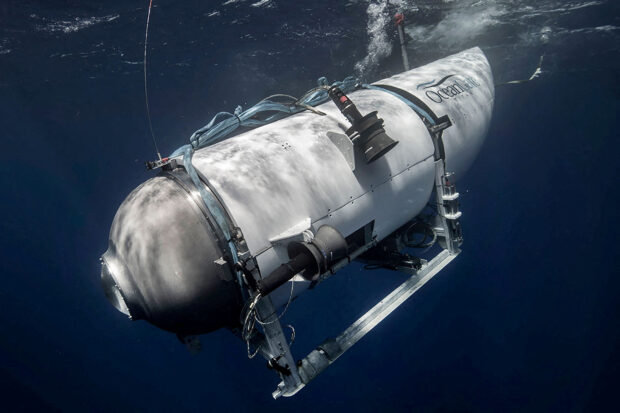Missing Titanic sub hours from running out of oxygen

The Titan submersible, operated by OceanGate Expeditions to explore the wreckage of the sunken Titanic off the coast of Newfoundland, dives in an undated photograph. (OceanGate Expeditions/Handout via REUTERS)
Air to a missing submersible with five people on board was expected to last just a few more hours if that on Thursday, the fifth day of a desperate multinational search in the vast Atlantic waters around the wreck of the Titanic.
The minivan-sized Titan, operated by U.S.-based OceanGate Expeditions, began its descent at 8 a.m. (1200 GMT) on Sunday but lost contact with its support ship near the end of what should have been a two-hour dive to the century-old shipwreck.
Having set off with 96 hours of air, according to the company, its oxygen tanks would likely be depleted some time on Thursday morning. Precisely when depends on factors such as whether the craft still has power and how calm those on board are, experts say, and assumes the Titan is still intact.
Rescue teams and relatives and friends of the Titan’s five occupants took hope when the U.S. Coast Guard said on Wednesday that Canadian search planes had recorded undersea noises using sonar buoys earlier that day and on Tuesday.
But the Coast Guard said remote-controlled underwater search vehicles directed to where the noises were detected had not yielded results and officials said the sounds might not have originated from the Titan.
“When you’re in the middle of a search-and-rescue case, you always have hope,” Coast Guard Captain Jamie Frederick said on Wednesday, adding analysis of the noises was inconclusive.
The French research ship Atalante, equipped with a robotic diving craft capable of reaching depths even below the Titanic wreck which lies about 12,500 feet (3,810 metres) below the surface, was moving into the area.
The French robot, called Victor 6,000, has arms that can be remotely controlled to help free a trapped craft or hook it to a ship to haul it up. The U.S. Navy is sending a special salvage system designed to lift large undersea objects.
DEEP-SEA ADVENTURE
The Titanic, which sank in 1912 on its maiden voyage after hitting an iceberg, killing more than 1,500 people, lies about 900 miles (1,450 km) east of Cape Cod, Massachusetts, and 400 miles (640 km) south of St. John’s, Newfoundland.
The Titan was carrying its pilot and four others on a deep-sea excursion to the shipwreck, capping a tourist adventure for which OceanGate charges $250,000 per person.
The passengers included British billionaire and adventurer Hamish Harding, 58, and Pakistani-born business magnate Shahzada Dawood, 48, with his 19-year-old son Suleman, who are both British citizens.
French oceanographer and leading Titanic expert Paul-Henri Nargeolet, 77, and Stockton Rush, founder and chief executive of OceanGate, were also reported to be on board. Rush is married to a descendant of two of the Titanic victims.
“We’re waiting anxiously, we hardly sleep,” said Mathieu Johann, Nargeolet’s editor at his publisher Harper Collins.
Sean Leet, who heads a company that jointly owns the support ship, the Polar Prince, said on Wednesday all protocols were followed but declined to explain how communication ceased.
“There’s still life support available on the submersible, and we’ll continue to hold out hope until the very end,” said Leet, chief executive of Miawpukek Horizon Maritime Services.
Questions about Titan’s safety were raised in 2018 during a symposium of submersible industry experts and in a lawsuit filed by OceanGate’s former head of marine operations, which was settled later that year.
Even if the Titan were located, retrieving it would present huge logistical challenges.
If the submersible had managed to return to the surface, spotting it would be difficult in the open sea and it is bolted shut from the outside, so those inside cannot exit without help.
If Titan is on the ocean floor, a rescue would have to contend with the immense pressures and total darkness at that depth. Titanic expert Tim Maltin said it would be “almost impossible to effect a sub-to-sub rescue” on the seabed.
“The Titanic wreck is broken into two parts and there is a cloud of debris around and in between them – finding a submersible among that is not simple,” said Jean Jarry, an engineer who worked for French research institute Ifremer.